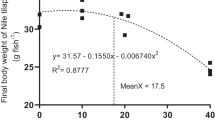Abstract
A study was conducted to determine the effects of varied brooding regimes on the performance of small bronze turkey poults and their grow-outs. One hundred and twenty (n = 120) poults were subjected to four brooding regimes of 0–5, 0–6, 0–7, and 0–8 weeks, designated as T1, T2, T3, and T4. Each brooding regime (treatment) was applied to 3 replicates of 10 poults/replicate in a completely randomized design. The feed intake of T1 poults was higher (P < 0.05) than that of the T2, T3, and T4 groups. There was no difference in the daily weight gain among all treatment groups. The T1 poults had a higher (P < 0.05) feed conversion ratio (FCR) than the T4 poults while the T1, T2, and T3 had similar FCR. The T1 group also had the highest feed/heating cost (USD 2.14) while the T4 recorded the lowest feed/heating cost (USD 2.01) resulting in 5.86% reduction in feed/heating cost. There were no differences in performance of the grow-out turkeys in all the production parameters measured, as well as in the feed cost per kilogram weight gain of the treatment groups. This result shows that small bronze-type turkeys brooded from 0 to 8 weeks had higher efficiency in terms of feed intake, FCR, and lower economic costs compared to those brooded from 0 to 5, 0–6, and 0–7 weeks at the poult stage. However, at grow-out stage, the period of brooding did not have any effects on their performance.
Similar content being viewed by others
References
Abeke, F. 2004. Management of chicks and growers, In: Production, N.I.o.A. (Ed.), Workshop Manual on Poultry Production, NAPRI Zaria. Zaria.
AOAC. 1995. Official Methods of Chemical Analysis. AOAC, Washington DC.
Barnes, H., J. Guy. 1996. Spiking mortality of turkeys (SMT) and related disorders-an update. Turkeys (United Kingdom) 5,10–17.
Cordeau, S., S. Barrington. 2010. Heat balance for two commercial broiler barns with solar preheated ventilation air. Biosystems engineering 107,232–241.
Edens, F., C. Parkhurst, M. Qureshi, I. Casas, G. Havenstein. 1997a. Atypical Escherichia coli strains and their association with poult enteritis and mortality syndrome. Poultry Science 76,952–960.
Edens, F., R. Qureshi, C. Parkhurst, M. Qureshi, G. Havenstein, I. Casas. 1997b. Characterization of two Escherichia coli isolates associated with poult enteritis and mortality syndrome. Poultry Science 76,1665–1673.
Feddes, J., E. Emmanuel, M. Zuidhof, D. Korver. 2003. Ventilation rate, air circulation, and bird disturbance: Effects on the incidence of cellulitis and broiler performance. Journal of applied poultry research 12,328–334.
Gencoglan, S., C. Gencoglan, A. Akyuz. 2009. Supplementary heat requirements when brooding tom turkey poults. South African Journal of Animal 39,1–9.
Haartsen, P. 1981. Aspects of heating animal houses. Page 79Environmental aspects of housing for animal production. Clark, JA. University of Nottingham, Butterworths., London.
Jin, S., A. Corless, J. Sell. 1998. Digestive system development in post-hatch poultry. World’s Poultry Science Journal 54,335–345.
Mendes, A., D. Moura, I. Nääs, G. Morello, T. Carvalho, R. Refatti, S. Paixai. 2013. Minimum ventilation systems and their effects on the initial stage of turkey production. Revista Brasileira de Ciencia Avicola 15,7–13.
Menegali, I., I. Tinôco, R. Gates, F. Baeta, C. Carvalho. 2009. Effect of Two Different Minimum Ventilation Systems on the Thermal Comfort and Productive Performance of Broiler Chickens in Winter Conditions. Page 62American Society of Agricultural and Biological Engineers. Livestock Environment VIII, Iguassu Falls, Brazil.
Nwaodu, C. 2005. Studies on the management practices of turkey producers in Imo State, Nigeria. Federal University of Technology, Owerri, Nigeria.
Okoli, I. 2005. Profitability begins with successful brooding. Success and Life.
Okoli, I., C. Nwodu, M. Uchegbu, O. Adesope. 2006. Brooding Management Practices of Smallholder Turkey Farmers in Imo State, Nigeria. Asia-Pacific Journal of Rural Development 16,23–31.
Okoli, I., C. Nwaodu, V. Odoemelam, M. Uchegbu, P. Ogbuewu, T. Iwuji, Kalla DJU. 2013. Reproductive Management of Turkeys Among Small-Holder Farmers in Imo State, Nigeria. Page 158The 4th International conference on Sustainable animal agriculture for developing countries. Langzhou, China.
Okoro, V., U. Ogundu, O. Kadurumba, M. Iloeje, C. Okoro, R. Nosike, S. Ibe. 2012. Genetic variations in locally adapted turkeys. 1. Additive and non-additive genetic effects on growth traits. Genomics and Quantitative Genetics 4,1–7.
Oluyemi, J., F. Roberts. 2000. Poultry production in warm wet climates. 2nd edition. Macmillian Press, London.
Peters, S., C. Ikeobi, O. Bamikole. 1997. Small hold turkey production in Ogun State Nigeria, INFPD, Bour, Senegal. Bour, Senegal.
Qureshi, M., F. Edens, G. Havenstein. 1997. Immune system dysfunction during exposure to poult enteritis and mortality syndrome agents. Poultry science 76,564–569.
SAS Institute. 2010. SAS/STAT 9.3 user’s guide survey data analysis. Page Statistical Analysis Software User’s Guide. SAS Institute Inc., Cary, NC. SAS Institute.
Turkoglu, M., M. Sarica, H. Eleroglu. 2005. Turkey Brooding. Page Otak Form-Ofset Samsun,. Turkey, Turkey.
Yahav, S., D. Shinder, M. Ruzal, M. Giloh, Y. Piestun. 2009. Controlling body temperature—the opportunities for highly productive domestic fowl. Body temperature control (ed. AB Cisneros and BL Goins),65–98.
Yahav, S., S. Druyan, M. Rusal, D. Shinder. 2011. Diurnally cycling temperature and ventilation affect young turkeys’ performance and sensible heat loss. Journal of Thermal Biology 36,334–339.
Author information
Authors and Affiliations
Corresponding author
Ethics declarations
Ethical approval was secured from the University Ethics committee before the commencement of the experiment and compliance with ethical standards was strictly adhered to.
Conflict of interest
The authors declare that they have no conflict of interest.
Rights and permissions
About this article
Cite this article
Nwaodu, C.H., Okoro, V.M.O., Uchegbu, M.C. et al. Effects of brooding periods on performance of poults and grow-out small bronze turkeys in hot humid tropical environment. Trop Anim Health Prod 50, 851–856 (2018). https://doi.org/10.1007/s11250-017-1507-1
Received:
Accepted:
Published:
Issue Date:
DOI: https://doi.org/10.1007/s11250-017-1507-1




